|
Dimbulagala:
History atop a mountain
Story and pictures by Mahil Wijesinghe
|

Stupa on the rocky cliff of the Dimbulagala hermitage |
Our 'stepping back into history' journey to Polonnaruwa, which took
us to some magnificent archaeological findings in the surrounding areas
of this ancient kingdom, winds to a close with a visit to Dimbulagala,
the hermitage of the monastic monks.
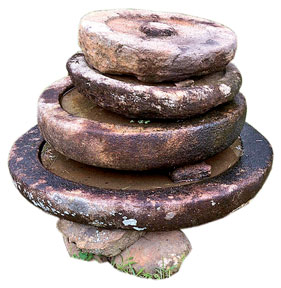 Our
journey, which began from Colombo, saw us stopping at Bakamuna to wonder
in awe at the Buduruwayaya Buddha statue, become completely enchanted
with the Somawathi Stupa and mesmerised by the stone cold elegance of
Medirigiriya Vatadage. Our
journey, which began from Colombo, saw us stopping at Bakamuna to wonder
in awe at the Buduruwayaya Buddha statue, become completely enchanted
with the Somawathi Stupa and mesmerised by the stone cold elegance of
Medirigiriya Vatadage.
Now on the final leg of the journey, we attempt to take in
Dimbulagala, the mountain range with about 500 rock caves, the hermitage
for monastic monks that has been continuously occupied since 3rd century
BC.
Located to the southeast of Polonnaruwa and 10 kilometres south of
Manampitiya, the rock spire of Dimbulagala, rises majestically from the
surrounding scrub jungle. Moving close once can see the Dimbulagala
mountain range with its jagged peaks, thrusting against the morning sky.
The placid water of the Dalukana tank add an odd kind of serenity to
the raw elegance of the Dimbulagala range, a nearly six-kilometer long
rocky outcrop that rises 1,753 feet above the plains.
The remains of stone structures, stupas and the caves could give one
the impression of the site simply being the ruins of a monastery. But
Dimbulagala is much more than that. A true historical monument, the
entire mountainous landscape is in fact of great archaeological value.
|
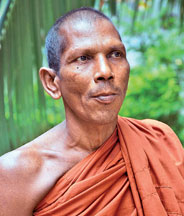
Millane Sri Siriyalankara Nayaka Thera, an Adivasi
Bhikkhu who is the Chief Priest of the Dimbulagala hermitage |
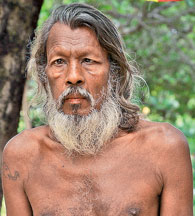
Hathiyage Amerasena, Adivasi clan Chieftain of
Dalukana
|
History has it that following the Chola invasion, great monasteries
of Anuradhapura, Abayagiri and Jetavanarama were abandoned and their
monks fled in terror. Seeking refuge in remote areas, many of them had
come to Dimbulagala, in the forests of Polonnaruwa.
Meditating monks
Dimbulagala had been a hermitage since ancient times and by medieval
period its caves had housed large numbers of meditating monks. It
provided a secure sanctuary to the fleeing monks, because of its remote
location, inaccessibility and isolation.
After the Sinhala Kingdom was restored, the kings of Polonnaruwa had
turned to the monks of Dimbulagala for guidance. Despite the declining
of morals and spiritual knowledge and ordination of monks in many parts
of the country due to the chaos and anarchy of the 10th and 11th
centuries, the monks of Dimbulagala had retained their sanctity,
devotion to contemplation, study and discipline.
Adivasi ordained
|
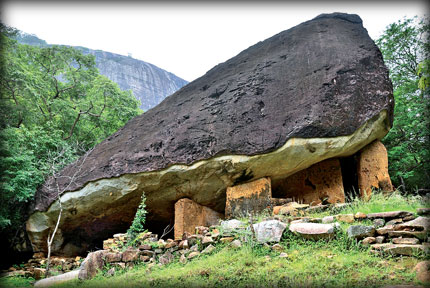
One of the caves at Namal Pokuna |
In his quest to restore Buddhism, King Parakrama Bahu had turned to
the head priest of Dimbulagala, the Venerable Mahakassapa, who is
credited with compiling the 'Katikavata' (Code of Discipline), which the
King had inscribed at the Gal Vihare. The King, it is recorded, had
restored the rites of ordination and established new codes of discipline
for priesthood with the support of Venerable Mahakassapa.
Dimbulagala had become the religious heart of the Polonnaruwa
Kingdom, and accorded the respect and pomp with several splendid
buildings and beautiful paintings to embellish the caves. The caves and
buildings of Namal Pokuna lies at the feet of Dimbulagala, as though
silent witness the ancient glory.
Modern history recorded Dimbulagala as being an overgrown ruin that
later went on to become the home of Adivasi (Veddha) Millane Yapa, the
last chieftain of the clan that lived in the caves of the Dimbulagala
forest. The Millana Yapa later decided to gift all the caves and
properties to the late Ven. Kithalagama Sri Seelalankara Nayaka Thera,
who converted the caves to the present hermitage at Dimbulagala.
Millana Yapa had also encouraged 12 young Adivasi boys to be ordained
as Samanera Bhikkhus at the hermitage. Ven. Millane Sri Siriyalankara
Thera, the former chief priest of Namal Pokuna Vihare and the current
chief priest of Dimbulagala hermitage was one of these 12 boys. He is
also the son of the Adivasi chief Millana Yapa.
 We
begin our exploration from the Namal Pokuna archaeological site at the
foot hills of the Dimbulagala mountain range. The path uphill was dotted
with rocky boulders, interspersed with tall, shade-giving trees. We
begin our exploration from the Namal Pokuna archaeological site at the
foot hills of the Dimbulagala mountain range. The path uphill was dotted
with rocky boulders, interspersed with tall, shade-giving trees.
At Namal Pokuna, we came across Hathiyage Amarasinghe, the current
Adivasi chieftain of Dalukana, a village in Dimbulagala range. He had
come to the temple to invite a Bhikkhu to a Dana. According Amarasinghe,
there are 1,600 Adivasi families living in eight villages in Dimbulagala
at present.
Nearly half an hour later, we reached the centre of the hill, where
most of the Dimbulagala ruins are found. The vantage point from the up
the hill gives a spectacular outline of the ancient city of Polonnaruwa
ancient, with the gleaming lakes, paddy fields and the cluster of
villages giving it a picturesque appearance.
|
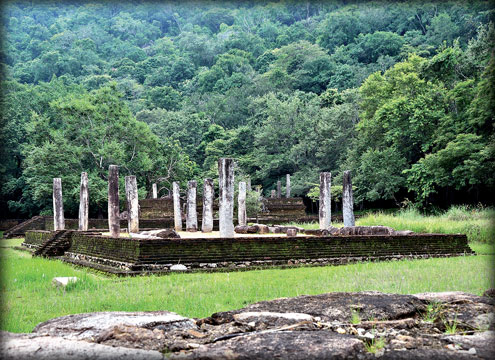
One of the caves at Namal Pokuna |
Exploring the natural caves and stone ruins that have made the Namal
Pokuna famous, we came across a huge torso of the Buddha, brick stupas,
stone pillars, drip ledged caves, ponds and stone walls almost resting
on each other. Namal Pokuna, relatively obscure and hence un-spoilt by
hordes of visitors, remains a tranquil spot- a confluence of history and
religion.
Continuing on, we come to the Dimbulagala hermitage, which lies in
cluster of rocky cliffs at the edge of the Dimbulagala range. From the
distance, one can see white the washed thin Stupa erected on one of the
rocky cliffs. There are large numbers of caves scattered in the
surrounding areas of the mountain, occupied by resident Bhikkhus of the
hermitage.
The Dimbulagala hermitage was founded by the late Ven. Kithalgama Sri
Seelalankara Nayaka Thera, who took the lead to protect the lives of the
people in the border villages during the peak of terrorism. The Bhikkhu
was gunned down at the hermitage by the Tamil Tigers. The tragedy
notwithstanding, the serenity you experience at the Dimbulagala range is
worth the arduous uphill climb. |

